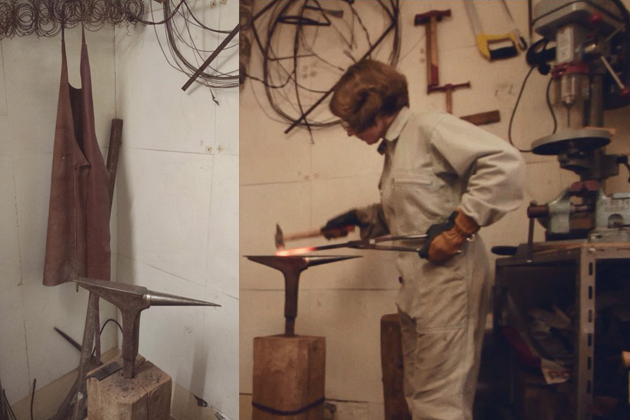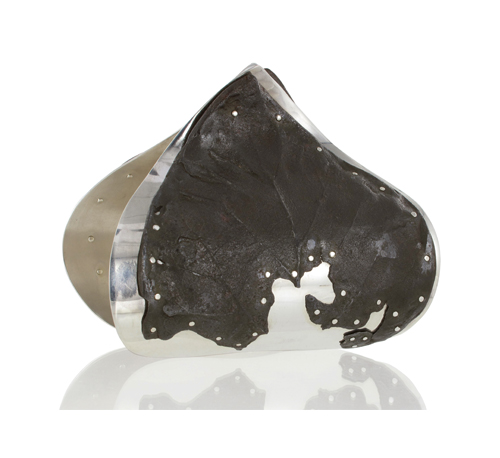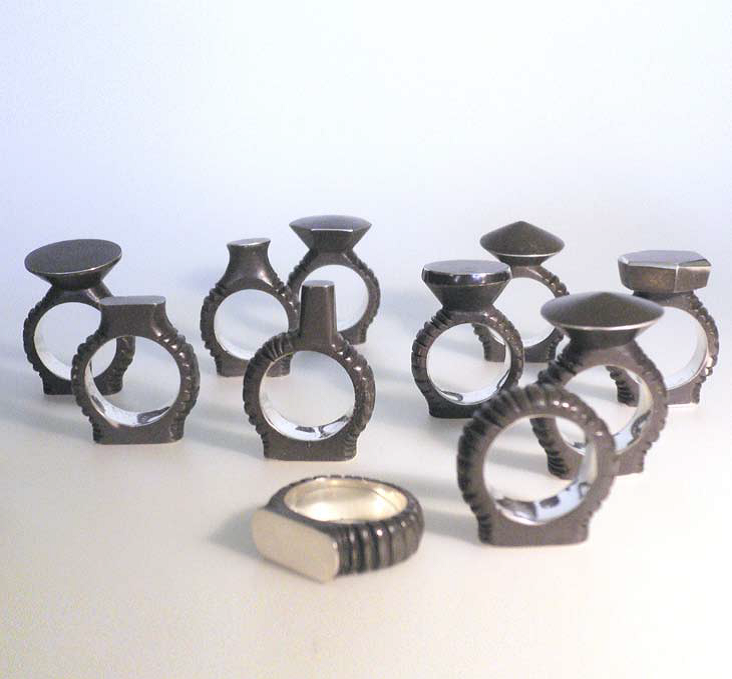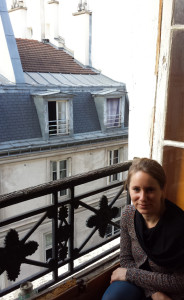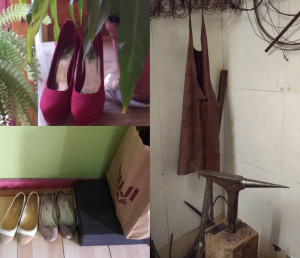 Couleurs pimpantes et plantes vertes laissent vite la place à des outils associés habituellement à l’univers masculin… Accueillies par le sourire juvénile de Marianne, la raison flanche : mais comment décline-t-on forgeron au féminin ?
Couleurs pimpantes et plantes vertes laissent vite la place à des outils associés habituellement à l’univers masculin… Accueillies par le sourire juvénile de Marianne, la raison flanche : mais comment décline-t-on forgeron au féminin ?
La première constatation devant les bijoux intrigants de Marianne Anselin, c’est l’alliance originale entre des matériaux mis au rebut, récupérés et travaillés avec soin et des métaux précieux pour aboutir à de réels bijoux, à la fois porteurs de sens et donnant envie d’être portés.
Elsa (EV) : Marianne, certaines de vos pièces évoquent la nature, d’autres un atelier de mécanique, et pourtant, leur look décalé, leur toucher, le doux éclat de l’or et la présence discrète de pierres précieuses donnent immédiatement envie de se les approprier. Comment expliquez-vous cela ?
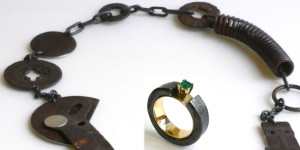 Marianne (MA) : Il me semble que si l’on prend plaisir à fabriquer des objets, à jouer avec eux, cela doit forcément susciter l’envie, non ? Le plaisir transpire or le bijou est un objet de plaisir… Ma formation de bijoutière a été complétée par une formation artistique à Strasbourg puis à Genève mais mon métier « choisi » est bien de m’exprimer par le biais du bijou. Or, celui-ci n’a de sens pour moi que dans sa mise en relation avec celui ou celle qui le porte. Mes pièces interrogent à la fois notre rapport à la planète et les relations humaines. Un tout.
Marianne (MA) : Il me semble que si l’on prend plaisir à fabriquer des objets, à jouer avec eux, cela doit forcément susciter l’envie, non ? Le plaisir transpire or le bijou est un objet de plaisir… Ma formation de bijoutière a été complétée par une formation artistique à Strasbourg puis à Genève mais mon métier « choisi » est bien de m’exprimer par le biais du bijou. Or, celui-ci n’a de sens pour moi que dans sa mise en relation avec celui ou celle qui le porte. Mes pièces interrogent à la fois notre rapport à la planète et les relations humaines. Un tout.
Les concepts que mes bijoux véhiculent n’excluent ni beauté intrinsèque ni le plaisir de l’œil que j’espère bien susciter et les matériaux dits pauvres sont travaillés de sorte à être anoblis et agréables à porter. Du reste je ne place pas la préciosité dans une valeur marchande, et par exemple, le fer, métal natif qui constitue la Terre et indissociable de l’ évolution humaine est pour moi un matériau très « précieux ».
EV : Mais quelles sont les techniques que vous utilisez ?
MA : Le travail de création commence par une promenade dans la nature et dans les lieux qui me sont chers. J’ai besoin de la marche dans le milieu naturel, campagne profonde, forêt… pour trouver ma « voix », l’inspiration, mais je flâne aussi dans des lieux abandonnés par l’homme, en friche.

Profondément admirative de ce qui nous entoure et surtout de la nature, j’ai toujours ramassé les objets qui attirent mon œil et gardé ceux qui m’émouvaient… Je me suis rendu compte petit à petit que je collectionnais des objets, soit pour leur forme, soit pour l’empreinte du temps qu’ils portent sur eux, comme le fer rouillé.
Pour le fer rouillé, c’est d’abord un travail de transformation car c’est l’objet, sa forme ou sa matière qui m’intéresse. Je le travaille avec des techniques de bijouterie classiques : je le martèle à froid pour ne pas perdre sa patine. Pour ne pas masquer le passage du temps, j’utilise souvent le rivetage et le sertissage pour l’associer à l’or ou l’argent qui seront en contact direct avec la peau. C’est souvent un travail d’ajustage pour obtenir un contraste évident, naturel.
En ce qui concerne les galets ou les végétaux, il m’arrive d’en prendre des empreintes et de les retravailler, de les détourner ou de les figer pour qu’ils deviennent portables. J’essaye de m’attacher à des détails que l’on prend si peu le temps de regarder.
EV : C’est assez rare de rencontrer une forge dans un atelier de bijoutière !
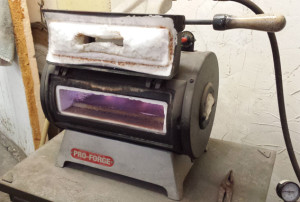 MA : Oui ! J’ai plaisir à me colleter à la matière et à la maîtriser. J’enfile régulièrement mon tablier et mes gants pour aller frapper sur l’enclume. Ce qui m’intéresse dans l’acte de forger c’est le geste physique, le lien entre la tête, les mains et la matière qui se fait, se défait… Quand on ne maîtrise pas à fond cette technique, il faut parfois laisser la matière vous guider. Comme il fait très chaud près de la forge et que c’est parfois fatigant, le cerveau se met en « off » et c’est le corps à corps qui parle, je laisse alors faire la main.
MA : Oui ! J’ai plaisir à me colleter à la matière et à la maîtriser. J’enfile régulièrement mon tablier et mes gants pour aller frapper sur l’enclume. Ce qui m’intéresse dans l’acte de forger c’est le geste physique, le lien entre la tête, les mains et la matière qui se fait, se défait… Quand on ne maîtrise pas à fond cette technique, il faut parfois laisser la matière vous guider. Comme il fait très chaud près de la forge et que c’est parfois fatigant, le cerveau se met en « off » et c’est le corps à corps qui parle, je laisse alors faire la main.
EV : Et où avez-vous appris ?
MA : J’ai découvert brièvement la forge à l ENSAMA (Olivier de Serre) à Paris, alors que je me spécialisais en dinanderie, en 2000. Dans chaque école, ensuite, Arts décoratifs de Strasbourg ou HEAD à Genève, j’ai utilisé toutes les possibilités qui m’étaient offertes d’approfondir ma technique et c’est à Genève, pour mon diplôme que j’ai réalisé mon tout premier bijou forgé, en fer. Enfin, Gilles Joneman, Maître d’Art dont j’ai été l’élève pendant 3 ans a été forgeron dans sa jeunesse et m’a beaucoup guidée, en particulier après notre voyage très marquant au Mali.
EV : Comment décririez-vous l’atelier ?
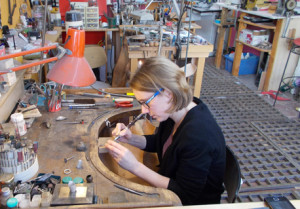 Il est situé au dernier étage d’un immeuble du quartier des bijoutiers, à Paris, avec une belle lumière. Il est assez vaste, composé d’une pièce principale avec 4 établis, une pièce insonorisée pour frapper sur l’enclume et une pièce de réception…
Il est situé au dernier étage d’un immeuble du quartier des bijoutiers, à Paris, avec une belle lumière. Il est assez vaste, composé d’une pièce principale avec 4 établis, une pièce insonorisée pour frapper sur l’enclume et une pièce de réception…
Enfin, c’est avant tout un atelier de filles ! Même si nous avons aussi un colocataire garçon, nous essayons d’en faire un lieu de travail et de partage convivial.

